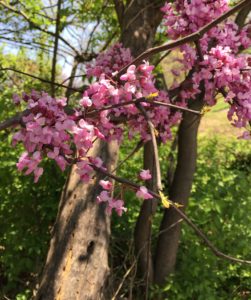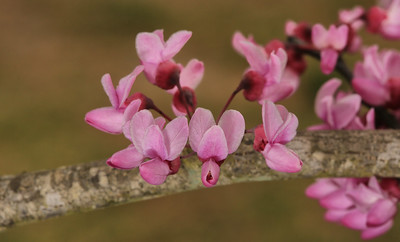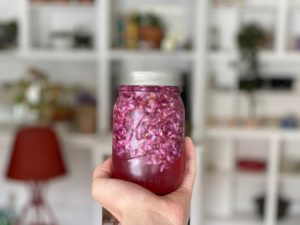
Photo by Peggy Humes.
April: Redbud (Cercis canadensis)
Spring is in the air and the majority of the plants around you are blooming! Cercis canadensis, commonly known as the Eastern Redbud, may be one of those trees that catch your eye. Redbud is a deciduous tree native to eastern North America easily identified from its pink to purplish pea-like flowers, which usually peak in bloom from March through May. Redbud’s bright blooms are just one of the identifiable characteristics of this native tree. As a member of the Legume (Fabaceae) family, additional characteristics for identifying this plant in your own backyard include:
- Flower petal arrangement: Redbuds have five flower petals (one banner, two wing, and two keel petals arranged symmetrically), like others in the Legume family, but the “banner” petal is smaller than the two “wing” petals in Redbuds. In addition, the wings are placed behind the banner, unlike the common arrangement of the wings below the banner. The keel petals project forward and open when mature to attract pollinators The wing and banner petals are a lighter shade of pink, while the two keel petals are darker pink.
- Bud growth form: Redbuds have “cauliflorous flowers”, meaning that instead of growing at the tips of the branches, flower bud clusters develop directly from the trunk and woody stem on the tree.
- Fruit form for seed dispersal: Redbuds grow pea-like pods, or “fruits”, that each contain around nine seeds.
- Leaf shape: The leaves of Redbud are usually heart-shaped.

Note the petal arrangement, with the banner and wing petals above and two darker keel petals below, as well as blossoms growing directly from the branch. Photo by Alan Cressler.
In addition to their showy flower, Redbuds are also useful trees. Native Americans have used infusions made from the roots and bark of Redbuds to treat a variety of ailments, including fever, congestion, vomiting, and whooping cough. Early Euro American settlers also used the bark to treat illnesses, including leukemia. Some native groups also used the wood to make bows and tool handles, and for use in basketry. The Navajos ate the seeds roasted.
Redbud blossoms are also edible! The flower blossoms are rich in Vitamin C, and can be eaten raw or pickled. They are often used as a pleasant addition to a spring salad or a garnish, but can also be used to make jelly. Redbuds are especially popular in Oklahoma, where it is the state tree. Oklahomans hold many festivals, gatherings, and food-related competitions dedicated to Redbuds.

Photo by Zack Plaster.
Here is a simple recipe for Pickled Redbud Blossoms from the McClung Museum’s former communications specialist and friend, Zack Plaster:
The first step is picking an equal amount of non-flowered and flowered buds. The flowered buds (which you can eat right off of the tree) taste a lot like snap peas, but slightly more sour.
After de-stemming all of them (which takes FOREVER, but cuts down on the bitterness), you add equal amounts of vinegar and water until the buds and flowers are totally submerged in an airtight jar, and add just a little bit of salt (maybe around 1 tsp per cup of water) and let sit for a few days. In years past I have used a white wine vinegar, but recently also tried out an apple cider vinegar. You definitely want to keep the jar someplace dark otherwise the vinegar and the flowers lose their beautiful color!
For more information:
- Moerman, Daniel. 2004. Native American Ethnobotany Database. Electronic document, http://naeb.brit.org/.
- Bebeau, G.D. 2015. Eastern Redbud. Friends of the Wild Flower Garden, Inc. Electronic document, https://www.friendsofthewildflowergarden.org/pages/plants/redbud.html.
- Hilty, John. 2020. Redbud. Illinois Wildflowers. Electronic document, https://www.illinoiswildflowers.info/trees/plants/redbud.htm.
- Mawby, Amy. 2020. What Am I Looking At: Fun with Flowers. Tyler Arboretum, Media, Pennsylvania. https://tylerarboretum.org/what-am-i-looking-at-fun-with-flowers/.
- Mahr, Susan. 2021. Eastern Redbud, Cercis canadensis. Wisconsin Horticulture, University of Wisconsin, Madison. Electronic document, https://hort.extension.wisc.edu/articles/eastern-redbud-cercis-canadensis/.
- Arbor Day Foundation. 2021. Redbud. Electronic document, https://www.arborday.org/programs/nationaltree/redbud.cfm.
- Plants for a Future. 2021. Cercis canadensis L. Electronic document, https://pfaf.org/user/Plant.aspx?LatinName=Cercis+canadensis.